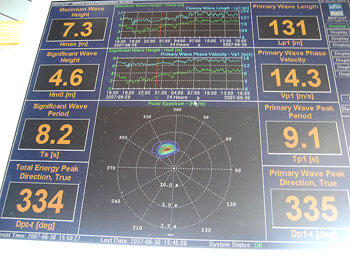Day 7 - 1 July
The day started off at midnight (00:00). However, here in the land of the midnight sun, it could just as well have been 12:00 noon!
Main content
Position: 73N 8E
Temperature: 5.0 (air) 6.4 (sea)
Wind speed: 7.4m/s
Wave height: 2.8
Visibility: excellent
Weather: overcast with some partially cloudy periods
We are above the arctic circle which is found at approximately 66 degrees N. On the island of Svalbard, just north of us, the sun does not set between 19 April and 23 August. We have not actually seen the midnight sun yet - we have 24 hours of continual daylight overcast skies!
This information screen is on the bridge. It tells all kinds of information about the waves.
The plot in the middle shows the energy and shape of the wave as well as the direction they are moving.
We reached the corner of Mohn's Ridge and Knipovich Ridge (a station within flying distance from Svalbard for the spare parts flight tomorrow), and set out a CTD on the shoulder of an old volcano, discovered in 2003.
The aim is to calibrate our instruments for a dive at a new station near a much younger volcano.
The depth here is around 2500m. The CTD was sent down to 2450. The scientists study the sensor data (temperature, reflectivity, turbidity, presence of reduced material (Eh) etc), looking for signature patterns that will indicate the possible presence of a hydrothermal vent. The information on the screen also indicates the interesting depths for opening the CTD bottles for water sampling.
Unfortunately, the half the bottles did not close properly, so the analysis results can only be approximate. The engineers are working on trying to rectify the problems for our next dives.
Today will be spent in more CTD dives and some gravity coring exercises. We will move from the slopes of this young volcano down the abyssal plain between the Knipovich Ridge and Svalbard.
We found a distinct anomaly!! The sensors recorded a significant increase in reduced chemicals that was supported by data in the lab. Now we just have to pin down the location a bit more precisely.
